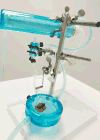Subzero organ preservation: the dawn of a new ice age?
- PMID: 28266941
- PMCID: PMC5520671
- DOI: 10.1097/MOT.0000000000000403
Subzero organ preservation: the dawn of a new ice age?
Abstract
Purpose of review: Herein, we review the field of subzero organ preservation with a focus on recent developments in hepatic supercooling.
Recent findings: Organ preservation is making a rapid shift from the decade old standard of storage on ice toward techniques that improve organ availability as well as preservation time. Long-term organ preservation would have tremendous benefits to the organ transplantation field, including better organ allocation, donor-recipient matching, as well as reduced preservation injury, and subsequent improvement of donor organ use. The formation of ice has proven an important limiting factor and novel techniques attempt to control or prevent freezing using cryoprotective agents, and highly controlled cooling regimens. Various techniques have been employed over the previous decades, including true organ freezing, vitrification, and subzero nonfreezing or supercooling. For most techniques, successful transplantation following long-term subzero preservation has remained elusive. Supercooling, however, recently delivered the first promising results, yielding survival after up to 4 days of supercooled preservation at -6°C.
Summary: As the field of organ preservation undergoes significant development, the field of subzero preservation also receives renewed interest. Although many obstacles remain to be overcome to make subzero preservation feasible, novel techniques are beginning to show their potential in achieving long-term preservation.
Conflict of interest statement
The authors of this manuscript have conflicts of interest to disclose. Dr. Uygun has a financial interest in Organ Solutions, a company focused on developing organ preservation technology. Dr. Uygun’s interests are managed by the MGH and Partners HealthCare in accordance with their conflict of interest policies.
Figures
Similar articles
-
Supercooling preservation and transplantation of the rat liver.Nat Protoc. 2015 Mar;10(3):484-94. doi: 10.1038/nprot.2015.011. Epub 2015 Feb 18. Nat Protoc. 2015. PMID: 25692985 Free PMC article.
-
Subzero non-frozen preservation of human livers in the supercooled state.Nat Protoc. 2020 Jun;15(6):2024-2040. doi: 10.1038/s41596-020-0319-3. Epub 2020 May 20. Nat Protoc. 2020. PMID: 32433625 Free PMC article.
-
Preservation of myocardial function and metabolism at subzero nonfreezing temperature storage of the heart.J Heart Lung Transplant. 1996 Nov;15(11):1101-7. J Heart Lung Transplant. 1996. PMID: 8956119
-
Cryopreservation of complex systems: the missing link in the regenerative medicine supply chain.Rejuvenation Res. 2006 Summer;9(2):279-91. doi: 10.1089/rej.2006.9.279. Rejuvenation Res. 2006. PMID: 16706656 Review.
-
[Advances in supercooling liver preservation].Zhonghua Wai Ke Za Zhi. 2020 May 1;58(5):397-400. doi: 10.3760/cma.j.cn112139-20190516-00285. Zhonghua Wai Ke Za Zhi. 2020. PMID: 32393008 Review. Chinese.
Cited by
-
Systems engineering the organ preservation process for transplantation.Curr Opin Biotechnol. 2019 Aug;58:192-201. doi: 10.1016/j.copbio.2019.05.015. Epub 2019 Jul 4. Curr Opin Biotechnol. 2019. PMID: 31280087 Free PMC article. Review.
-
Zebrafish as a New Tool in Heart Preservation Research.J Cardiovasc Dev Dis. 2021 Apr 8;8(4):39. doi: 10.3390/jcdd8040039. J Cardiovasc Dev Dis. 2021. PMID: 33917701 Free PMC article. Review.
-
Organ Preservation into the 2020s: The Era of Dynamic Intervention.Transfus Med Hemother. 2019 Jun;46(3):151-172. doi: 10.1159/000499610. Epub 2019 May 3. Transfus Med Hemother. 2019. PMID: 31244584 Free PMC article. Review.
-
Isochoric supercooled preservation and revival of human cardiac microtissues.Commun Biol. 2021 Sep 22;4(1):1118. doi: 10.1038/s42003-021-02650-9. Commun Biol. 2021. PMID: 34552201 Free PMC article.
-
Current practice and novel approaches in organ preservation.Front Transplant. 2023 Jun 8;2:1156845. doi: 10.3389/frtra.2023.1156845. eCollection 2023. Front Transplant. 2023. PMID: 38993842 Free PMC article. Review.
References
-
- Porte RJ, Ploeg RJ, Hansen B, van Bockel JH, Thorogood J, Persijn GG, et al. Long-term graft survival after liver transplantation in the UW era: Late effects of cold ischemia and primary dysfunction. European multicentre study group. Transpl Int. 1998;11(Suppl 1):S164–7. - PubMed
-
- Ravikumar R, Jassem W, Mergental H, Heaton N, Mirza D, Perera MT, et al. Liver transplantation after ex vivo normothermic machine preservation: A phase 1 (first-in-man) clinical trial. Am J Transplant. 2016 Jan 11; - PubMed
-
- Lewis JK, Bischof JC, Braslavsky I, Brockbank KG, Fahy GM, Fuller BJ, et al. The grand challenges of organ banking: Proceedings from the first global summit on complex tissue cryopreservation. Cryobiology. 2016 Apr;72(2):169–82. - PubMed
-
- Storey KB. Life in a frozen state: Adaptive strategies for natural freeze tolerance in amphibians and reptiles. Am J Physiol. 1990 Mar;258(3 Pt 2):R559–68. - PubMed
-
- Mazur P. Freezing of living cells: Mechanisms and implications. Am J Physiol. 1984 Sep;247(3 Pt 1):C125–42. - PubMed
Publication types
MeSH terms
Grants and funding
LinkOut - more resources
Full Text Sources
Other Literature Sources
Medical
Research Materials


